| Siege of Jadotville | |||||||
|---|---|---|---|---|---|---|---|
| Part of Operation Morthor in the Congo Crisis | |||||||
| |||||||
| Belligerents | |||||||
| Commanders and leaders | |||||||
|
| ||||||
| Strength | |||||||
500[3] -
| |||||||
| Casualties and losses | |||||||
|
3[7] - 300 killed[8][9] 8[7] - 1,000 wounded[10] | |||||||
As part of the larger Congo Crisis (1960–1964), the siege of Jadotville [ʒa.do.vil] began on 13 September 1961, lasting for five days.[13] While serving under the United Nations Operation in the Congo (Opération des Nations Unies au Congo, ONUC), a small contingent of the Irish Army's 35th Battalion, designated "A" Company, were besieged at the UN base near the mining town of Jadotville (modern-day Likasi) by Katangese forces loyal to the secessionist State of Katanga. The siege took place during the seven-day escalation of hostilities between ONUC and Katangese forces during Operation Morthor. Although the contingent of 156 Irish soldiers repelled several attacks by a larger force, they eventually surrendered to the Katangese forces after running out of ammunition and water. The Irish company inflicted approximately 1,300 casualties (including, according to some estimates, up to 300 killed) on the Katangese force, with no deaths amongst the Irish "A" Company. A relief column of approximately 500 Indian, Irish, and Swedish UN troops, sent to break the siege, was unsuccessful and suffered several casualties (including at least five killed). The captured Irish company was held as prisoners of war for approximately one month, before being released on 15 October as part of a prisoner exchange.[14]
- ^ Ciaran Byrne (27 July 2016). "The True Story of the Heroic Battle That Inspired the New Netflix Film The Siege of Jadotville". Time. Retrieved 31 October 2017.
- ^ Tom Farrell (9 October 2011). "Band of brothers: Tom Farrell talks to some of the survivors 50 years on". Irish Independent. Retrieved 30 October 2017. Although he is described in the text as a 'platoon commander' who was eventually a captain, the accompanying photograph is marked 'Lt Noel Carey'.
- ^ de Kémoularia, Claude (2007). Une vie à tire-d'aile: Mémoires. Fayard. p. 142. ISBN 9782213658476.
Selon les précisions que me donna De Troye, les 12 mercenaires blancs qui commandaient les 500 gendarmes katangais avaient , en réalité , redouté de voir leurs troupes indisciplinées massacrer les soldats de l'ONU , ce qui eût été catastrophique pour eux
- ^ Power 2005, p. 153: "the Katangans had begun moving in large numbers of troops culminating in a brigade strength unit of approximately 3,000"
- ^ Patrick Quinlan (1961). Nominal Roll 'A' Company, 35 Irish Bn Irish Contingent JADOTVILLE - 18 Sept 1961.
- ^ Independent Review Group Report 2021, p.112, 152: "The Irish contingent was 'B' Company, 35 Inf Bn, and the Indian contingent 'B' Company of the 3/1 Gurkha Rifles.
- ^ a b Valahu, Mugur (1963). Ci-gît le Katanga, 1961, 1962, 1963. Nouvelles Editions Latines. p. 259-260.
A Jadotville, du côté katangais, il y a eu pendant les trois jours de bagarres, deux soldats africains et un mercenaire français tués , et huit blessés
- ^ Cite error: The named reference
time1was invoked but never defined (see the help page). - ^ Mockaitis, Thomas R. (1999). Peace Operations and Intrastate Conflict. Greenwood Publishing Group. p. 29. ISBN 9780275961732.
the entire garrison of Jadotville was forced to surrender on 17 September [..to..] a force variously estimated at between 2,000 and 5,000, suffering five wounded while inflicting perhaps 150 casualties on the gendarmes
- ^ "Film 'Siege of Jadotville' to reveal heroism of Irish troops". irishtimes.com. Irish Times. 9 August 2014. Retrieved 15 January 2022.
- ^ Asante 2014, p. 302-303.
- ^ Irish Military Archives Exhibition.
- ^ O'Neill 2002, p. 135.
- ^ O'Neill 2002, p. 139.
